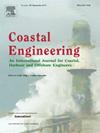Field experiment study to assess critical wave conditions leading to failure of mangrove Rhizophora stylosa
IF 4.5
2区 工程技术
Q1 ENGINEERING, CIVIL
引用次数: 0
Abstract
Mangroves can attenuate tsunamis, storm surges, and waves and significantly reduce coastal hazards. Their protective functions as natural barriers have drawn attention as a prime example of green infrastructure/Ecosystem-based Disaster Risk Reduction (Eco-DRR)/Nature-based Solution (NbS) for coastal resilience. While hydrodynamic models are commonly used to estimate wave attenuation by mangrove forests, critical thresholds for mangrove tree failure under wave impacts and the associated wave conditions remain underexplored and are often excluded from such assessment. This study investigates the maximum bending moment of the mangrove tree, mainly Rhizophora stylosa, based on a field survey conducted on Iriomote Island, Okinawa, Japan. A practical estimation formula is developed by integrating field data with linear small amplitude wave theory. The results, including empirical relationships for critical wave conditions leading to the bending failure of mangroves, offer valuable insights for designing and optimizing mangrove-based coastal protection strategies.
红树林破坏临界波条件的田间试验研究
红树林可以减弱海啸、风暴潮和海浪,并显著减少沿海灾害。它们作为天然屏障的保护功能,作为绿色基础设施/基于生态系统的灾害风险减少(Eco-DRR)/基于自然的解决方案(NbS)的沿海恢复力的典范,引起了人们的关注。虽然水动力模型通常用于估计红树林的波浪衰减,但波浪影响和相关波浪条件下红树林破坏的临界阈值仍未得到充分探索,而且往往被排除在这种评估之外。本研究以日本冲绳县伊里摩特岛为研究对象,对红树的最大弯矩进行了调查。将实测数据与线性小振幅波理论相结合,推导出实用的估算公式。研究结果,包括导致红树林弯曲破坏的关键波浪条件的经验关系,为设计和优化基于红树林的海岸保护策略提供了有价值的见解。
本文章由计算机程序翻译,如有差异,请以英文原文为准。
求助全文
约1分钟内获得全文
求助全文
来源期刊

Coastal Engineering
工程技术-工程:大洋
CiteScore
9.20
自引率
13.60%
发文量
0
审稿时长
3.5 months
期刊介绍:
Coastal Engineering is an international medium for coastal engineers and scientists. Combining practical applications with modern technological and scientific approaches, such as mathematical and numerical modelling, laboratory and field observations and experiments, it publishes fundamental studies as well as case studies on the following aspects of coastal, harbour and offshore engineering: waves, currents and sediment transport; coastal, estuarine and offshore morphology; technical and functional design of coastal and harbour structures; morphological and environmental impact of coastal, harbour and offshore structures.
 求助内容:
求助内容: 应助结果提醒方式:
应助结果提醒方式:


